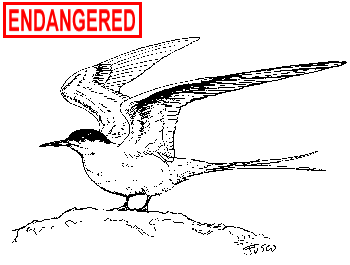Roseate Tern
Sterna dougallii

Habitat: Strictly saltwater coastlines; almost never seen inland.
Weight: Approximately 4 ounces.
Length: 14-17 inches.
Wingspan: 30 inches.
Life Expectancy: Banding indicates 9 years of age.
Food: Small fish, occasionally mollusks.
Status: Federally and state endangered.
Identification: Adults have a white body and black head cap. The deeply forked tail measures 6 to 8 inches in length. The black bill is red at the base, varying with the season and the age of the bird; as the breeding season progresses from incubation to the care and feeding of chicks, more and more of the base turns pinkish-red. The rosy tint on the breast is rarely visible in summer, but the bird's bright orange-red legs and feet are easy to distinguish. Both sexes are similar. Chicks and fledglings have black bills, legs and feet. The voice is a high-pitched, rasping "aaak" and soft "chivy."
Range: Roseate terns nest in colonies on sand/gravel beaches or pebbly/rocky offshore islands along the Atlantic coast from Nova Scotia south to Long Island, New York, and on the southern tip of Florida. Roseates that nest in the northeastern United States appear to winter primarily in the waters off Trinidad and northern South America from the Pacific coast of Columbia to eastern Brazil.
Reproduction: Roseate terns arrive in Connecticut in late April and early May. The first eggs are laid by the third week of May in shallow scrapes, or depressions, sometimes lined with dried vegetation. Nests are often concealed by vegetation or rocks. The 1 to 2 eggs are pale buff with small dots of brown. The adults take turns incubating the eggs and bringing small fish to the chicks. The eggs hatch in 23 to 24 days, and the young fledge about 26 to 30 days after hatching. Birds that lose their nests or young will produce new nests into late July and occasionally into early August. Roseate terns usually breed and nest at 3 years of age.
Reason for Decline: Historically, the roseate tern population suffered losses due to the millinery trade. Roseate tern productivity has also been affected by increased human recreation and disturbance in coastal areas, as well as by predation by great black-backed and herring gulls, owls and nocturnal-feeding mammals. Increasing numbers of gulls and human activity on or near coastal barrier islands have greatly reduced available nesting habitat for the roseate tern population in northeastern North America. Many traditional nesting sites in southern New England were abandoned during the 1940s and 1950s when great black-backed and herring gulls rapidly expanded their nesting ranges. These large, aggressive gulls stake out nesting territories in early spring before the terns return from their wintering areas. Gulls have taken over most of the outer islands preferred by nesting terns.
History in Connecticut: In the late 1800s, unrestricted market hunting for the millinery trade devastated the roseate tern population on the Atlantic coast. After harvest for commercial purposes was prohibited by law, the population recovered and at times equaled the number of common terns. Roseate tern numbers declined again in the 1970s and 1980s when gull populations increased.
The third largest roseate tern colony in North America exists in Connecticut at Falkner Island, which is now part of the Stewart B. McKinney National Wildlife Refuge. Approximately 175 to 200 pairs of terns breed there every year. This population has been studied in detail since 1978. Other colony sites that have been used in Connecticut during 1989 include Tuxis Island near Madison and Duck Island near Clinton. Several small islands in the New London area were occupied by roseate terns in the 1970s.
Approximately one-fourth of the roseate tern breeding population in a given year at Falkner Island does not return the following year. Presently, it is not known if this loss is due to mortality or emigration to other colony sites.
Interesting Facts: According to the U.S. Fish and Wildlife Service (USFWS), islands with manned lighthouses were favorite nesting areas for roseates because the human presence deterred large gulls from nesting. Since the automation of almost all lighthouses, gulls have moved in and displaced the terns. The USFWS officially listed the northeastern breeding population of the roseate tern as endangered in December, 1987.
Adult terns are mainly preyed on by avian species such as owls, gulls and raptors. Eggs and young are also vulnerable to predation, as well as to adverse weather conditions and disturbance. Predation may completely wipe out production in a given colony. The combination of adult mortality, delayed maturity and low productivity can, in a short time, result in serious population declines unless they are offset by subsequent years of high productivity.
Roseate terns catch their prey by diving headfirst into the water. Their diet of small fish may have led to the alias mackerel gull, which also reflects their membership in the gull family. Graceful tern was another common name given to this adept flier.
In 1975, studies on Gull Island, New York, reported the hybridization of common terns and roseate terns. Similar crosses have not been documented since.
Protective Legislation: Federal - Endangered Species Act of 1973, Migratory Bird Treaty Act of 1918. State - Connecticut General Statutes Sec. 26-311.
What You Can Do: Respect all roseate tern nesting areas that are fenced or posted for the birds' protection. Do not approach or linger near roseate terns or their nests. Avoid landing vessels at offshore islands inhabited by terns.

The production of this Endangered and Threatened Species Fact Sheet
Series is made possible by donations to the Endangered Species/Wildlife Income Tax
Checkoff Fund.
(rev. 12/99)

